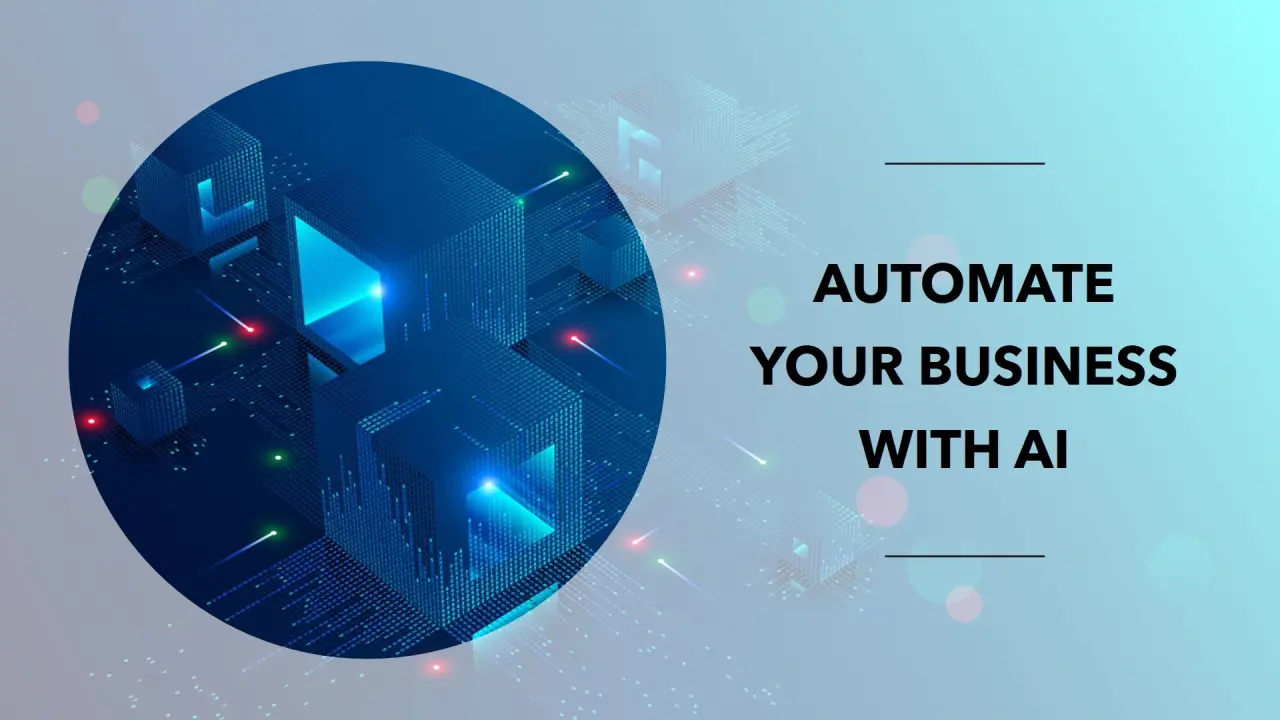What was once a futuristic buzzword is now the engine driving modern business. In 2025, Artificial Intelligence isn’t just enhancing efficiency — it’s redefining how companies scale, innovate, and connect. From hyperautomation to intelligent customer experiences, AI automation in business is transforming every corner of the business world. Whether you’re a startup founder or leading an enterprise, understanding this shift isn’t optional — it’s mission-critical.
1. Hyperautomation: Automating at Scale
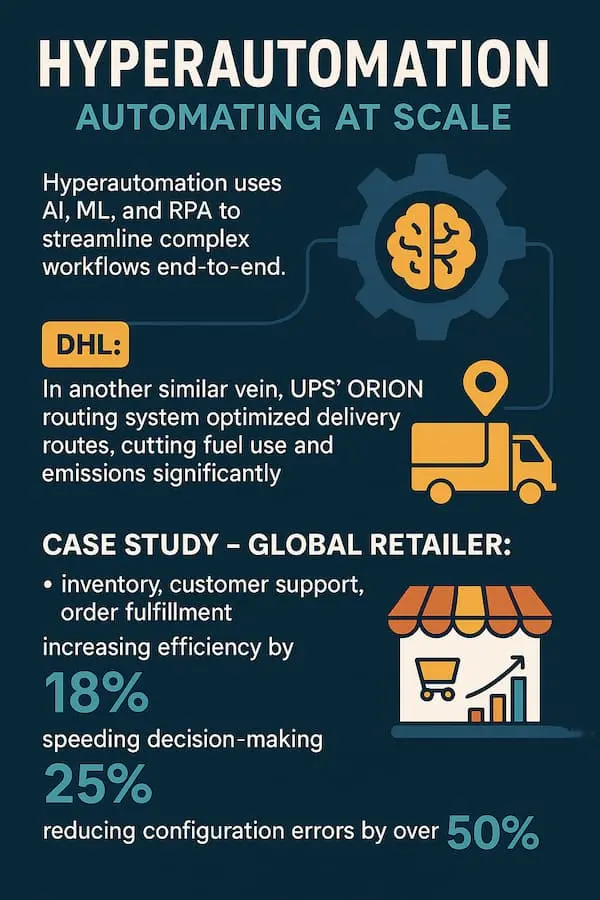
Hyperautomation is an advanced approach that uses AI (artificial intelligence), ML (machine learning), and RPA (robotic process automation) to automate entire workflows, not just simple repetitive tasks, but also complex, decision-based processes.
Real-World Example: UPS ORION System
UPS developed the ORION (On-Road Integrated Optimization and Navigation) system:
-
It uses AI to optimize delivery routes.
-
Impact: Cut fuel consumption and reduced emissions significantly.
This is a real example of how hyperautomation creates both cost efficiency and sustainability.
Case Study – Global Retailer
A global retailer used hyperautomation in:
-
Inventory Management – Predict stock needs using AI.
-
Customer Support – Deploy chatbots and smart ticketing.
-
Order Fulfillment – Streamline shipping via RPA.
Results:
-
18% boost in operational efficiency
-
25% faster decision-making
-
50%+ reduction in configuration errors
In Simple Terms:
Hyperautomation is like giving your business a brain (AI) and robotic arms (RPA) to work smarter and faster, across every department.
2. Agentic AI and Intelligent Process Automation (IPA)
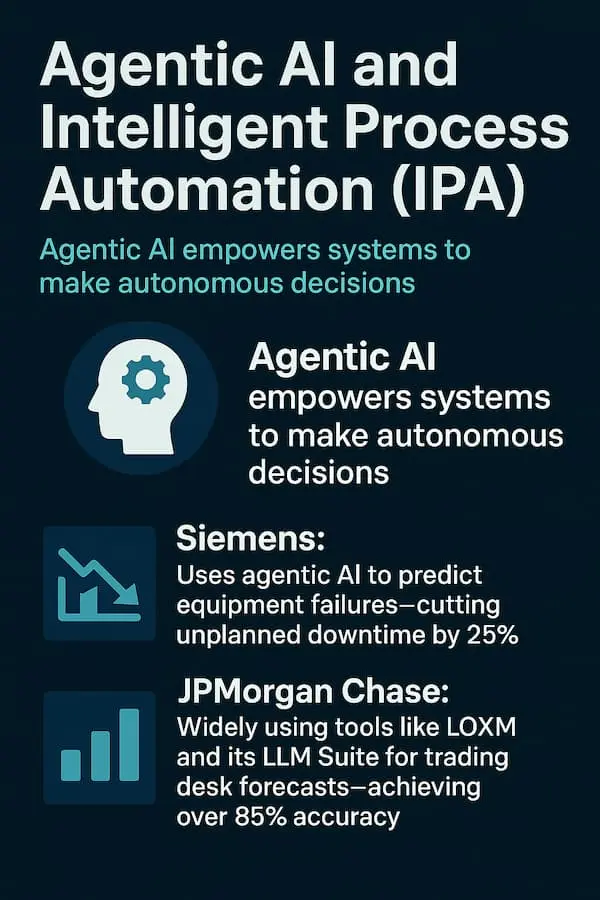
Agentic AI refers to AI systems that can make decisions autonomously, based on goals, data, and real-time feedback. Think of it like an intelligent agent that can observe, plan, act, and learn — without constant human instructions.
It’s more advanced than simple automation. It doesn’t just follow rules — it evaluates situations, makes decisions, and adapts over time.
What is Intelligent Process Automation (IPA)?
IPA combines:
-
AI (like computer vision, NLP)
-
Machine Learning
-
RPA (Robotic Process Automation)
Together, IPA helps automate decision-based tasks, not just manual workflows. It makes processes smarter and faster — across finance, logistics, customer service, etc.
Example: Siemens
-
Siemens uses Agentic AI to predict when equipment might fail before it actually happens.
-
Result: They’ve cut unplanned downtime by 25%, saving costs and improving productivity.
This is Agentic AI taking proactive decisions to prevent loss.
Example: JPMorgan Chase
-
JPMorgan uses tools like LOXM (an execution algorithm) and an LLM Suite to forecast trading strategies.
-
These systems analyze market data and trends, then make predictions with over 85% accuracy.
It shows how agentic systems are actively supporting decision-making at scale — especially in high-stakes areas like finance.
In Simple Terms:
Agentic AI is like hiring a digital strategist — one that:
-
Learns continuously
-
Makes informed decisions
-
Works 24/7
-
Doesn’t need to be told every step
And when combined with IPA, it becomes a hyper-efficient digital workforce.
3. Generative AI: Revamping Content and Customer Experience
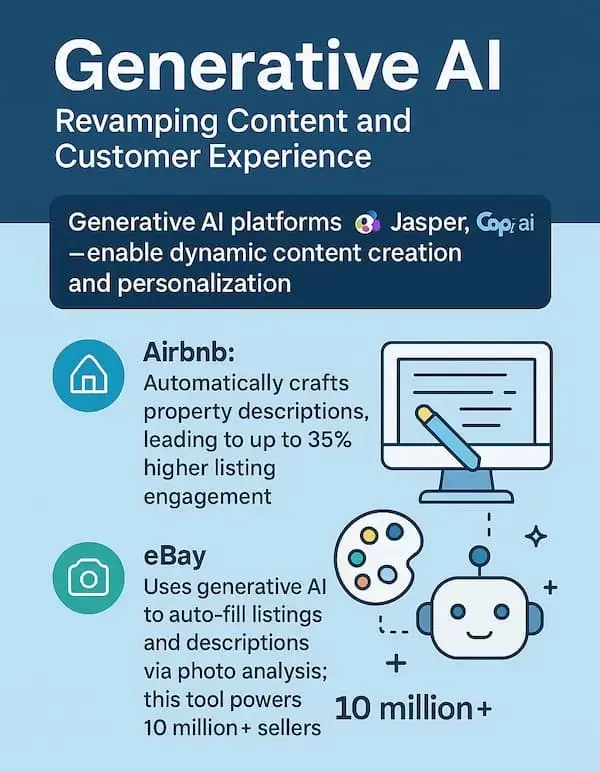
Generative AI refers to AI systems that can create new content, such as text, images, audio, or code, based on patterns they’ve learned. These models can write blog posts, make ad copy, generate images, or even produce music.
Think of it as AI that “creates” instead of just analyzing.
Popular platforms:
-
Jasper, Copy.ai, ChatGPT (for text)
-
DALL·E, Midjourney (for images)
Business Use: Content & Experience
Generative AI is transforming how businesses:
-
Create marketing and product content automatically.
-
Personalize user experience at scale.
-
Reduce the time/cost of writing or designing manually.
Example: Airbnb
-
Airbnb uses generative AI to write property descriptions automatically.
-
Result: Listings see up to 35% higher engagement because of clearer, more appealing content.
That’s smarter, faster content creation — no human copywriter needed!
Example: eBay
-
eBay applies generative AI to analyze product photos and then auto-fill listing titles and descriptions.
-
This feature supports over 10 million sellers, making the process faster and easier.
AI automation in business shows how generative AI reduces seller workload and improves content quality for shoppers.
In Simple Terms:
Generative AI gives businesses a creative assistant that works at scale, writing, describing, and personalizing — faster than any team ever could.
4. AI in Cybersecurity & Fraud Detection
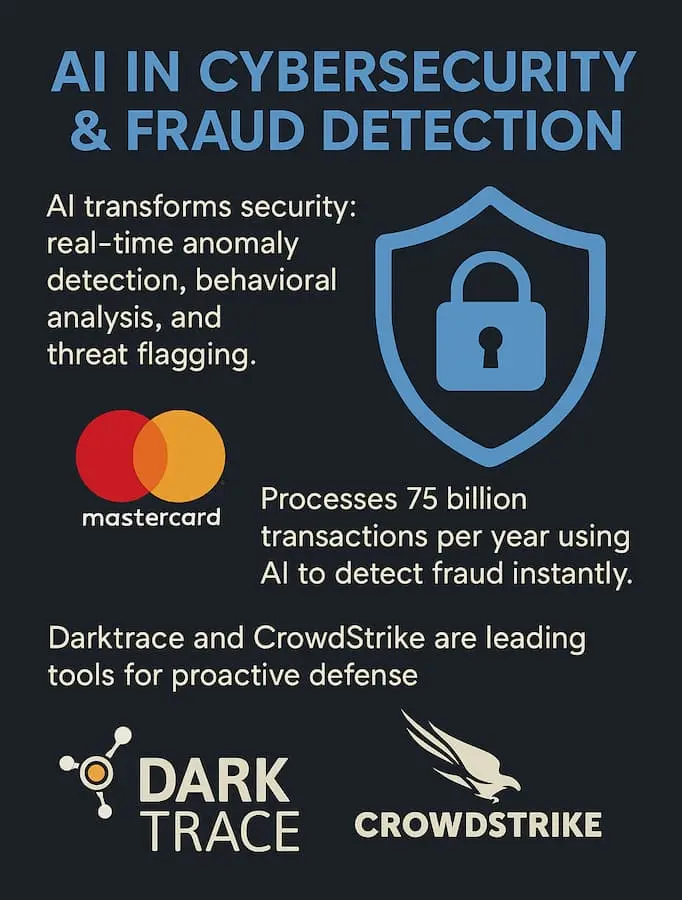
AI is revolutionizing cybersecurity by enabling systems to:
-
Detect anomalies in real time (e.g., suspicious logins or behaviors)
-
Analyze user behavior patterns (behavioral biometrics)
-
Flag threats or fraud instantly and accurately
Unlike traditional systems that rely on preset rules, AI can learn and adapt, detecting even new or subtle threats.
Example: Mastercard
-
Mastercard uses AI to analyze 75 billion+ transactions annually.
-
It detects fraud in real-time, preventing unauthorized transactions before they go through.
This is AI making fraud detection both faster and smarter.
Tools: Darktrace & CrowdStrike
-
Darktrace uses AI to autonomously detect and respond to threats inside networks.
-
CrowdStrike provides endpoint protection and threat intelligence using AI-driven analytics.
Both tools focus on proactive defense, identifying attacks before they cause damage.
In Simple Terms:
AI is like a digital security guard that never sleeps, constantly watching for anything suspicious and reacting in milliseconds, far beyond what human teams can manage manually.
5. No-Code Automation: Democratizing AI
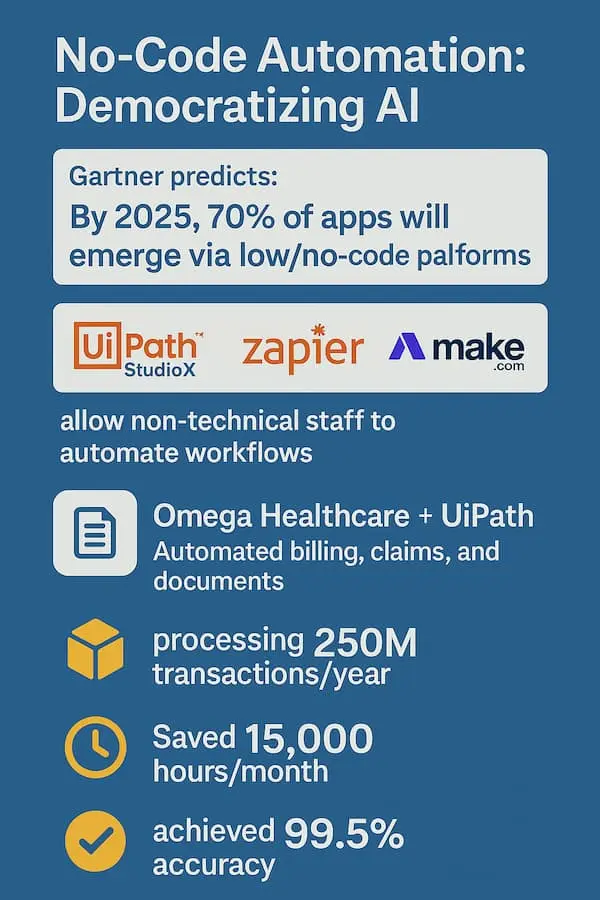
No-code automation means building apps and workflows without needing to write code. It allows non-technical users to automate tasks using drag-and-drop interfaces and prebuilt tools.
This approach “democratizes AI” — making automation accessible to business users, not just developers.
The Trend
Gartner predicts that by 2025, 70% of new applications will be created using low-code/no-code platforms.
That’s a massive shift toward accessible innovation.
Popular Tools
-
UiPath StudioX – For automating repetitive tasks with a simple interface
-
Zapier – Connects apps and automates workflows
-
Make.com – Visual platform to build complex automations easily
These tools are popular in HR, marketing, healthcare, finance, and beyond.
Case Study: Omega Healthcare + UiPath
Omega Healthcare used UiPath to automate:
-
Billing, claims processing, and documentation
Impact:
-
250 million transactions/year processed
-
15,000+ hours saved per month
-
99.5% process accuracy achieved
(businessinsider.com.)
In Simple Terms:
No-code automation puts AI power in everyone’s hands, speeding up work, reducing errors, and saving time — all without a single line of code.
6. Human + AI: The New Workflow
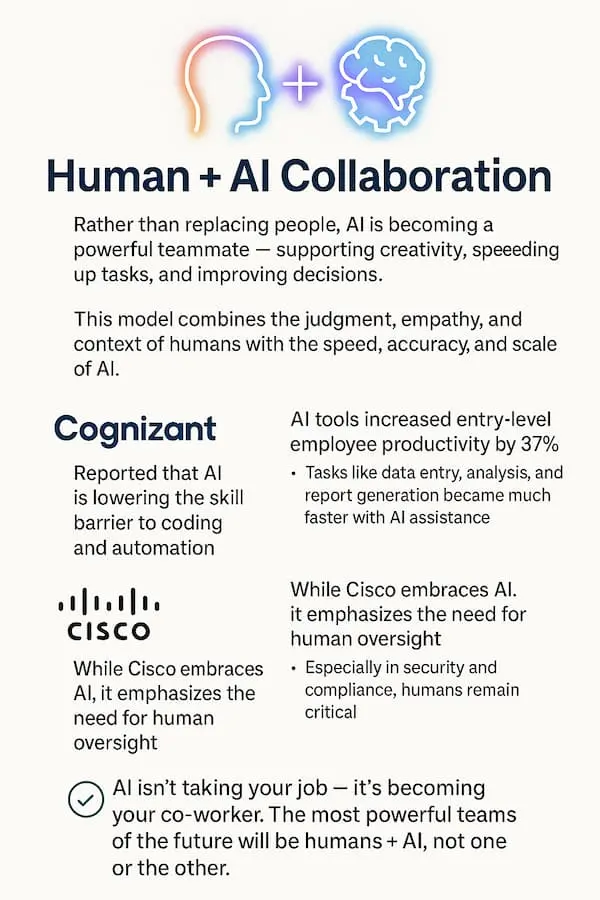
Rather than replacing people, AI is becoming a powerful teammate, supporting creativity, speeding up tasks, and improving decisions.
This model combines the judgment, empathy, and context of humans with the speed, accuracy, and scale of AI.
Examples:
1. Cognizant
-
AI tools increased entry-level employee productivity by 37%.
-
Tasks like data entry, analysis, and report generation became much faster with AI assistance.
2. The Federal Reserve
-
Reported that AI is lowering the skill barrier to coding and automation.
-
More employees can now build and automate without deep technical knowledge.
3. Cisco
-
While Cisco embraces AI, it emphasizes the need for human oversight.
-
Especially in security and compliance, humans remain critical.
In Simple Terms:
AI isn’t taking your job, it’s becoming your co-worker. The most powerful teams of the future will be humans + AI, not one or the other.
7. ROI from AI: Investing Smart
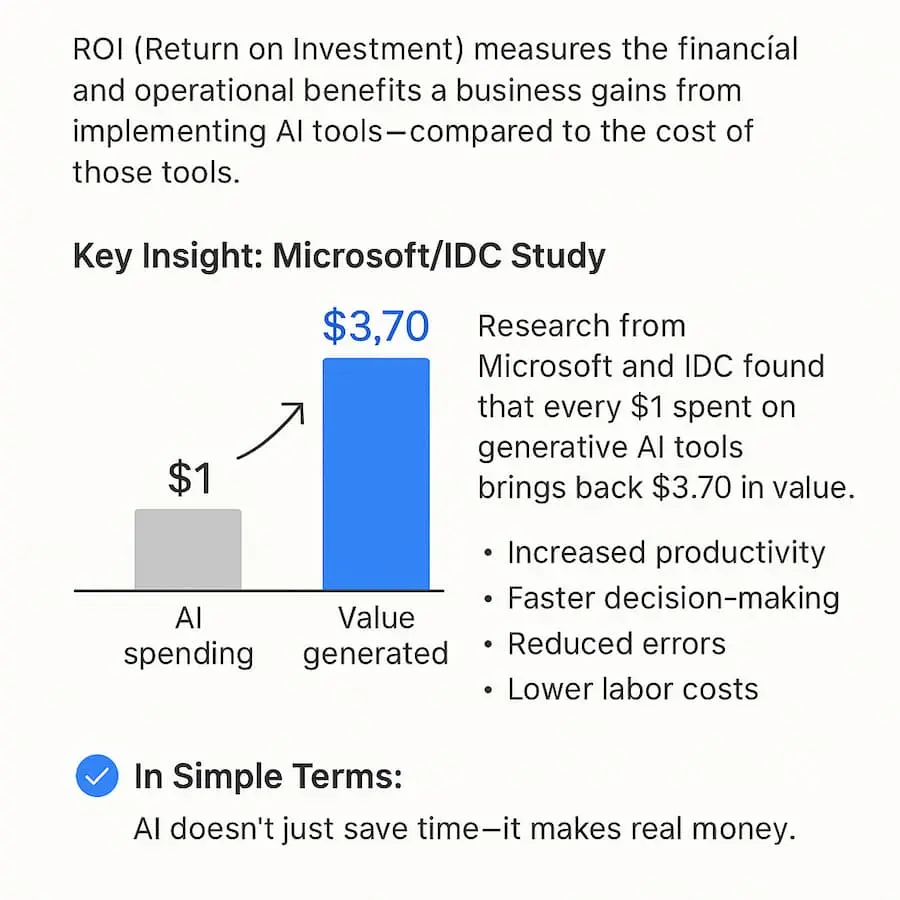
ROI (Return on Investment) from AI measures the financial and operational benefits a business gains from implementing AI tools, compared to the cost of those tools.
It helps answer the core question: “Is AI worth it?”
Increasingly, research shows the answer is a resounding yes.
Key Insight: Microsoft/IDC Study
-
According to research from Microsoft and IDC, every $1 spent on generative AI tools brings back $3.70 in value. blogs.microsoft.com.
-
This return includes:
-
Increased productivity
-
Faster decision-making
-
Reduced errors
-
Lower labor costs
-
That’s a 370% ROI — making AI one of the most impactful investments today.
Case Study: FinRobot Pilot
A company piloting FinRobot, an AI-powered ERP agent, reported:
-
40% faster process completion
-
94% fewer errors in complex tasks like finance, procurement, or HR ops
This shows how AI directly boosts both speed and accuracy, reducing time spent and costly mistakes.
In Simple Terms:
AI doesn’t just save time — it makes real money. Smart investments in AI are paying off across industries, proving it’s not just hype — it’s a measurable business impact.
Real-World Success Stories
| Company | Use Case | Outcome |
|---|---|---|
| Omega Healthcare + UiPath | Document processing & claims | 15K employee-hours saved/month, 99.5% accuracy businessinsider.com |
| Commonwealth Bank Australia | 2,000+ AI models & AWS migration | Personalized service using 157B data points |
| BMW | AI manufacturing and marketing | Centralized data and improved production |
| WPP | AI-generated marketing ads | Marketed Super Bowl ads at lower cost/time |
| Amazon | Supply chain optimization | Reduced inventory waste and delays |
FAQs: AI automation in business
Q: How fast can I expect results from AI?
A: Often within 3–6 months from pilot launch; ROI is usually 30–40% in the first year .
Q: Do I need data science experts?
A: Get started with no-code platforms and ex-internal champions; for complex agentic systems, invest in specialized skill or partners.
Q: What about job losses?
A: While automation may shift roles, companies like Cognizant report increased productivity and opportunity for fresh graduates, not mass layoffs.
Q: How do we ensure fairness in AI?
A: Use tools (Watson OpenScale, PAIR) to track bias. Maintain transparency and audit logs. Train diverse teams .
Q: What’s a smart first step?
A: Pick a high-volume, rule-based process—invoice matching, support ticket triage, or CRM updates—for a focused pilot.
Final Takeaways
-
Start Small, Scale Smart: Begin with targeted pilots for quick wins.
-
Measure ROI: Track time saved, error drops, cost reduction.
-
Upskill Your Team: Equip staff with AI tools and change management training.
-
Prioritize Ethics: Embed fairness, transparency, and security.
-
Partner for Success: Align with tech providers who offer support and share your values.
AI automation in business 2025 is more than just tech—it’s a strategic imperative. Businesses embracing it responsibly today will lead tomorrow’s markets. Ready to take your first AI pilots? Explore actionable guides or subscribe to our newsletter.


